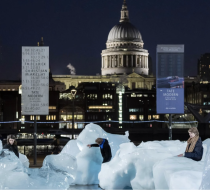Ice Watch London Favorite
The Guardian:
Olafur Eliasson is putting the chill into climate change. The revered Scandinavian artist has placed 24 large blocks of centuries-old ice, harvested from the Nuup Kangerlua fjord in Greenland, in a circle outside the Tate Modern in London, with another six on display in the City.
The purpose of Ice Watch London, a collaboration with award-winning Greenlandic geologist Minik Rosing, is to bring the effects of climate change closer to home, putting people in direct contact with its effects so that they can feel – and even sniff and lick – the ice as it slowly melts away.
“I’ve been studying behavioural psychology, and looking into the consequences of experience,” says the Icelandic-Danish artist. “What does it mean to experience something? Does it change you or not change you? It turns out that data alone only promotes a small degree of change. So in order to create the massive behavioural change needed [to tackle climate change] we have to emotionalise that data, make it physically tangible.”
Each ice block was fished out of the sea after it had broken away from the Greenland ice sheet – then transported in fridge containers to the UK (“Just like the ones that take your frozen prawns to Selfridges,” grins Rosing). The blocks, which weigh between 1.5 and 6 tonnes each, all have to be of a shape that is unlikely to break – when Ice Watch was on display in Copenhagen and Paris, the public were fond of scrambling up and sliding down the blocks.
Hear it pop … melting ice in London.
Of course, such interaction is the point of the project. As Eliasson puts it: “Roll around on it, climb on it, listen to it!”
The icebergs are made up of compressed snow rather than frozen water, meaning that each block contains tiny little bubbles of air. Put your ear up against them and you will hear a magical popping and fizzing sound.
“It sounds so beautiful,” says Rosing. “That is air that was trapped before we started polluting the atmosphere. Those bubbles have almost half the CO2 content as the air outside the iceberg. It was trapped maybe 10,000 years ago, maybe 100,000, so you can smell what air used to smell like before we polluted it. And you can take a drink of it, beautiful, natural water.”
The artwork arrives here to coincide with the Intergovernmental Panel on Climate Change’s latest stark warning that we have only 12 years to limit the worst effects of climate change. Eliasson and Rosing both point out the rather chilling statistic that 10,000 blocks of ice such as the ones on display in London are falling from the ice sheet every single second. However, they both passionately believe that focusing on scare stories is the wrong way to tackle climate change. “Instead of fear-based narratives, you need a positive narrative to make people change their behaviour,” says Eliasson, “and that’s why I think the culture sector has a strong mandate to take on some leadership here.”
“We have to provide a glimpse of hope,” adds Rosing. “People think the scientists come with the bad news about climate change but actually we come with the good news. We understand what’s happening, we know exactly what needs to be done and we actually have the means to fix it. The only reason we’ve been able to upset the global environment system is because we have enormous power. If we direct that same enormous power to improving the system, we can get it back on track.”
Eliasson’s is perhaps best known here for his 2003 Tate Modern installation The Weather Project, which hung a gigantic sun in the gallery’s turbine hall and attracted over two million visitors. His work has often focused on environmental themes: Green River used uranine, a non-toxic dye, to turn rivers in Stockholm, Tokyo and LA a dazzling bright green, while his Little Sun project provided small, solar-powered lamps to local entrepreneurs in communities where electricity was scarce. Even during the installation of this latest work, which started on Monday, Eliasson says his ice blocks have had an unusual effect on people: “The crane guy outside who was lifting and putting them down said ‘You know what? These are actually really heavy!’ Another woman touched it and said ‘wow, it’s really cold!’ Of course she knew this but the knowledge of her hand is so different to the knowledge in our heads.”
Ice Watch is set to run until 21 December, providing the weather doesn’t melt them away before. After that date, any ice left unmelted will be taken to local community and cultural institutions as part of an extended educational programme.
The exhibition comes before a major retrospective of Eliasson’s work at the Tate Modern that starts on 11 July 2019. That, too, will have a climate focus, perhaps inevitably so given Eliasson’s longstanding interest in environmental matters. For the catalogue, he has interviewed Elke Weber, the psychologist whose research into human behaviour has shaped his recent thinking about how to change people’s actions through art. The show will also contain a work from 20 years ago, in which Eliasson flew over Iceland documenting glaciers from above with a camera.
“It’s one of my oldest works, but also one of the first where I was focusing on the question of climate and glaciers,” he says.
“And now,” adds Rosing, striking a rare forlorn note, “those glaciers will probably be gone.”








